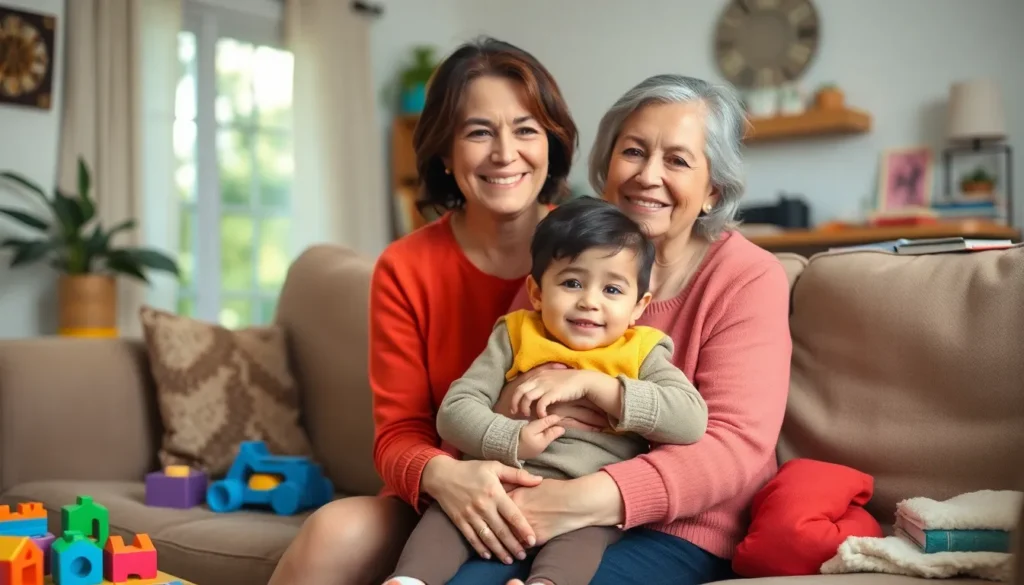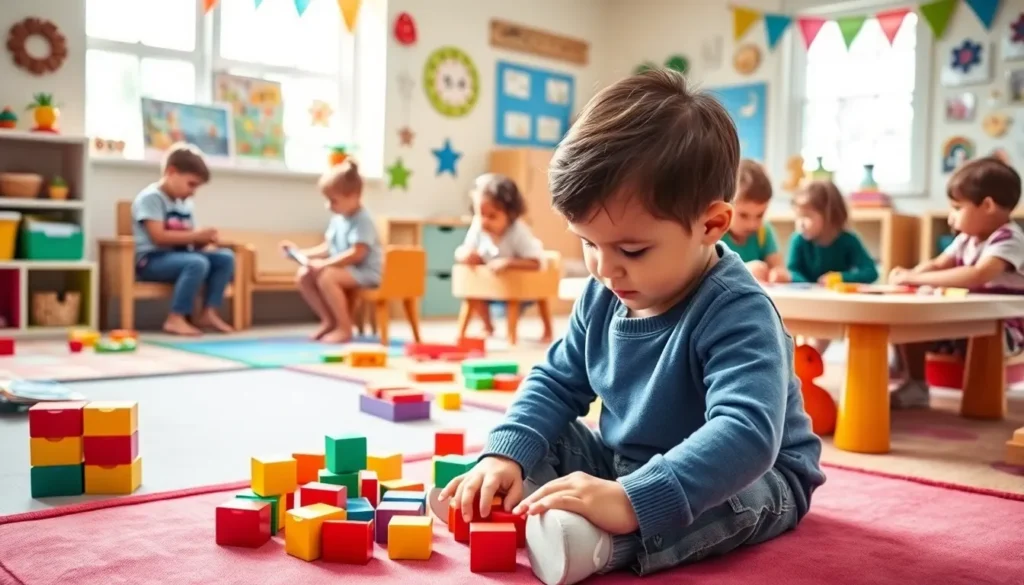Imagine a place where a child’s laughter echoes off the walls, where bedtime stories are shared, and where love fills the air like the aroma of freshly baked cookies. Welcome to the world of foster homes. These nurturing havens provide a safe refuge for children in need, offering them not just a roof over their heads but a chance to thrive.
In a foster home, kids find more than just temporary shelter; they discover a family that believes in them. It’s a place where they can heal, grow, and dream big. While the journey may have its challenges, the rewards of fostering can be as sweet as that last cookie in the jar. Dive into the heartwarming world of foster care, where every child deserves a second chance and every family can make a difference.
Table of Contents
ToggleWhat Is a Foster Home?
A foster home provides a temporary, safe environment for children who cannot live with their biological families. Such homes foster loving relationships where children receive emotional, physical, and educational support. Caregivers in these homes, often referred to as foster parents, play a crucial role in the child’s development and stability.
Foster homes offer essential services, including access to healthcare and counseling. A structured routine typically enhances the child’s sense of security and belonging. Many foster homes also focus on maintaining connections with the child’s biological family when possible. This connection can aid in the child’s emotional healing and support their overall well-being.
State agencies regulate foster homes to ensure compliance with safety and care standards. Each foster child has unique needs, and foster parents often receive training to address these effectively. In some cases, children may stay in foster care for several weeks, months, or even years, depending on their situation and reunification goals.
The fostering process includes assessments to match children with suitable homes. Agencies aim to create placements that consider the child’s age, background, and personal interests. With this approach, foster families can create an environment tailored to encourage each child’s growth and healing.
Foster homes significantly impact children’s lives, providing opportunities that promote resilience and hope. They create a supportive atmosphere that nurtures personal development while building strong emotional foundations. Each successful foster placement contributes to a child’s journey toward a stable and fulfilling future.
Importance of Foster Homes

Foster homes play a vital role in the lives of children in need. They create an environment where safety and support thrive.
Supporting Children in Need
Foster homes serve as a refuge for children facing challenging circumstances. Caregivers provide emotional stability, helping children process trauma. Families in these homes facilitate access to essential resources such as education and healthcare. Moreover, nurturing relationships foster resilience, allowing children to envision brighter futures. Support systems within foster homes empower children to explore their interests and talents. Consistent encouragement enhances self-esteem and builds trust in caregivers. All these aspects contribute significantly to the healing journey of vulnerable youth.
Providing Stability and Care
Stability serves as a cornerstone of foster care. Structured routines establish a sense of normalcy in children’s lives, promoting emotional security. Caregivers prioritize consistent schedules to create an atmosphere of predictability. This predictable environment aids in reducing anxiety, allowing children to focus on their personal growth. Quality care within foster homes enhances overall well-being. Caregivers address immediate physical needs, including nutritious meals and safe living conditions. Mental health support plays a crucial role, equipping children to navigate their challenges effectively. Overall, the stability and care within foster homes contribute significantly to a child’s development and future.
Types of Foster Homes
Foster homes take various forms, each tailored to meet the unique needs of children. Understanding these different types provides insight into the fostering landscape.
Traditional Foster Care
Traditional foster care typically involves placing children in homes with foster parents who provide general support. These homes cater to children of all ages who need temporary care. Foster parents in this category offer emotional and physical stability, helping children navigate transitions. Family routines and household dynamics foster a sense of normalcy. While each situation varies, the primary goal remains the same: to ensure that children receive the care and attention necessary for their development. State regulations guide these homes, ensuring safety and consistency in care practices.
Specialized Foster Care
Specialized foster care addresses the unique needs of children with specific challenges, such as medical conditions or behavioral issues. Caregivers in this category often possess training in trauma-informed care or other specialized areas. This type of foster home may focus on children with disabilities or those requiring additional emotional support. Children placed in specialized homes receive tailored interventions that promote healing and growth. Resources and therapies provided enhance development, helping children adapt to their circumstances. By recognizing individual needs, specialized foster parents create environments that allow children to flourish.
The Foster Care Process
Foster care involves a structured approach to ensuring the well-being of children in need. Each step focuses on providing a safe and nurturing environment.
Requirements for Foster Parents
Foster parents must meet specific eligibility requirements. They typically need to be at least 21 years old, undergo background checks, and provide personal references. A stable income ensures financial security for the child’s needs. Potential foster parents also complete training programs aimed at equipping them with necessary skills. Emotional resilience demonstrates the ability to handle challenging situations effectively. Building a supportive network contributes significantly to fostering success.
Steps to Becoming a Foster Parent
Becoming a foster parent involves several clear steps. First, interested individuals contact their local child welfare agency. Next, they fill out an application detailing their background and motivation to foster. Completing home studies ensures a safe living environment for children. After training sessions, prospective foster parents receive information about policies and procedures. Finally, children are matched with foster parents based on their unique needs and the family’s capabilities. Ongoing support from agencies helps foster parents navigate the emotional aspects of caregiving.
Challenges in Foster Care
Foster care presents numerous challenges for both children and parents involved. Acknowledging these difficulties contributes to better solutions and improved experiences for everyone.
Emotional Impact on Children
Children in foster care often grapple with emotional trauma from separation. They face issues related to loss and instability, impacting their mental health. Attachments to caregivers can be complicated, leading to feelings of anxiety and fear of rejection. Support from trained professionals can help these children process their experiences. Access to counseling services facilitates coping strategies and emotional healing, reducing long-term effects on their well-being. Stability within a nurturing environment aids recovery, encouraging exploration of their identity and fostering resilience.
Issues Faced by Foster Parents
Foster parents encounter various challenges in their caregiving roles. Many deal with emotional strain when witnessing children cope with trauma. Accessing resources can present obstacles, as navigating bureaucracy often proves overwhelming. Training expectations may vary, leaving some caregivers feeling unprepared for specific situations. Developing effective communication with biological families can be difficult but is essential for children’s emotional health. Support networks for foster parents also frequently lack availability, amplifying feelings of isolation. Regular communication with agencies ensures foster parents receive necessary guidance and can build confidence in their responsibilities.
Foster homes serve as essential sanctuaries for children in need, providing safety and nurturing environments that foster healing and growth. The dedication of foster parents plays a pivotal role in shaping the lives of these vulnerable youth, offering them emotional stability and access to vital resources.
While challenges exist within the foster care system, the rewards of fostering far outweigh the difficulties. Each successful placement not only transforms a child’s life but also enriches the foster family’s experience. By embracing the journey of fostering, individuals contribute to a brighter future for children, empowering them to overcome their past and dream of a hopeful tomorrow.




